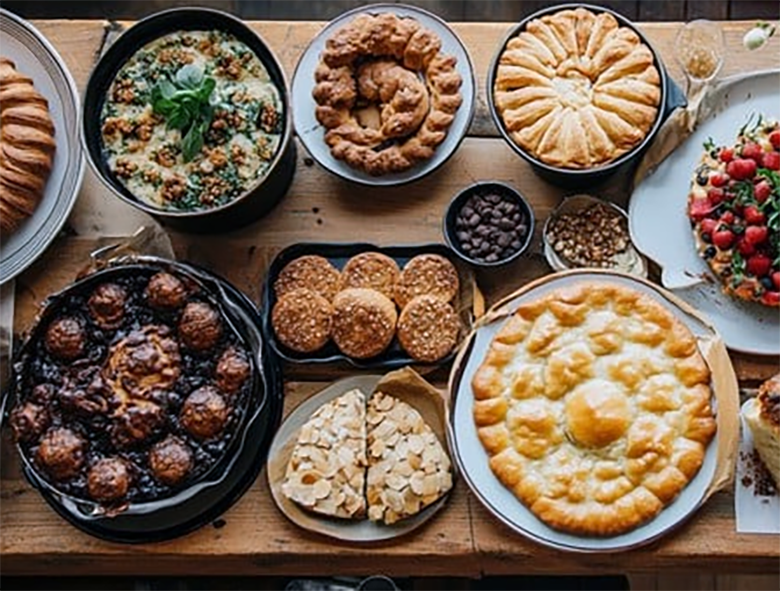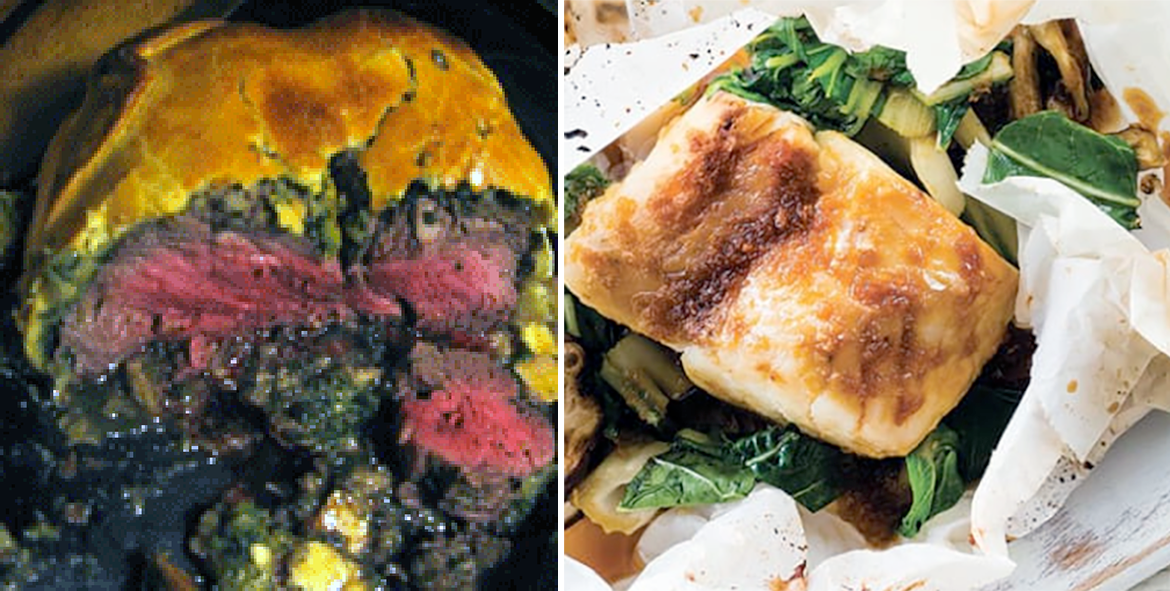FabulousFusionFood's Baking Recipes 4th Page
 A range of baked goods.
A range of baked goods.
Welcome to FabulousFusionFood's Baking Recipes Page — This is a continuation of an entire series of pages that will, I hope, allow my visitors to better navigate this site. As well as displaying recipes by name, country and region of origin I am now planning a whole series of pages where recipes can be located by meal type and main ingredient. This page gives a listing of all the baking recipes added to this site. Baking is defined as a technique for the prolonged cooking of food using dry heat by the action of conduction. Baking is normally done in an oven, but goods may also be baked in hot ashes or on hot stones. Baking differs from Roasting Recipes in that a lower temperature is typically used and the items are cooked for a longer period of time. Baking is a much older process than most people think and foods were probably originally baked in embers or with hot stones (which is how bread may have started). Only later did specialist ovens develop. Though most baked goods tend to be bread or cake-based some other dishes such as pasta dishes and vegetable dishes may also be baked. Stews are often also technically baked in an oven, but are not classed as 'baked goods' in that they are more liquid than solid at the end of the cooking process.
Baking is a method of preparing food that uses dry heat, typically in an oven, but can also be done in hot ashes, or on hot stones. The most common baked item is bread, but many other types of foods can be baked. Heat is gradually transferred "from the surface of cakes, biscuits and cookies, and pieces of bread to their centre, typically conducted at elevated temperatures surpassing 150°C. Dry heat cooking imparts a distinctive richness to foods through the processes of caramelization and surface browning. As heat travels through, it transforms batters and doughs into baked goods and more with a firm dry crust and a softer centre. Baking can be combined with grilling to produce a hybrid barbecue variant by using both methods simultaneously, or one after the other. Baking is related to barbecuing because the concept of the masonry oven is similar to that of a smoke pit.
In addition to bread, baking is used to prepare cakes, pastries, pies, tarts, quiches, biscuits and cookies, scones, crackers, pretzels, and more. These popular items are known collectively as 'baked goods', and are often sold at a bakery, which is a store that carries only baked goods, or at markets, grocery stores, farmers markets or through other venues.
 Beef en croûte (left) and fish en papillote (right).
Beef en croûte (left) and fish en papillote (right).
The alphabetical list of all the baking recipes on this site follows, (limited to 100 recipes per page). There are 2205 recipes in total:
Page 4 of 23
| Brazo Gitano (Puerto Rican Swiss Roll) Origin: Puerto Rico | Byrek me Spinaq (Spinach Pie) Origin: Albania | Cake de Fruta Confitada (Candied Fruit Cake) Origin: Ecuador |
| Bread and Butter Pudding Origin: British | Bysedd Melys (Sweet Fingers) Origin: Welsh | Cake sarrasin au blé noir, aux algues et à la truite (Savoury cake with buckwheat, seaweed and trout) Origin: France |
| Bread and Butter Pudding II Origin: British | Cabbage and Bacon Origin: Ireland | Calendula and Orange Cake Origin: American |
| Breadfruit and Saltfish Bread Origin: Saint Vincent | Cabbage and Potato Favourite Origin: Ireland | Calzone Origin: Italy |
| Breadfruit Pie Origin: Saint Lucia | Caca boeuf (Beef Patties) Origin: Guadeloupe | Canastitas de Queso (Cheese-filled Baskets) Origin: Spain |
| Brenneslekake (Norwgian Nettle and Honey Cake) Origin: Norway | Caccabinam Fusilem (Fluid Casserole) Origin: Roman | Candied Papaya Origin: Jamaica |
| Brioche Mousseline (Brioche Loaf) Origin: France | Cacen Blât Cwrens Duon (Blackcurrant Pie) Origin: Welsh | Candied Sweet Potatoes Origin: Jamaica |
| Brioche Raisin Snails Origin: Denmark | Cacen Blât Gwsberis (Gooseberry Pie) Origin: Welsh | Candy Cane Cheesecake Origin: American |
| Brithyll a Chig Moch (Baked Trout with Bacon) Origin: Welsh | Cacen Blât Llus (Bilberry Pie) Origin: Welsh | Canella Biscuits Origin: Britain |
| Brithyll mewn Bacwn (Trout Wrapped in Bacon) Origin: Welsh | Cacen Blât Mwyar Duon (Blackberry Pie) Origin: Welsh | Cannelés bretons (Breton cannelés) Origin: France |
| Broccoli Pasty Origin: England | Cacen Blât Riwbob (Rhubarb Pie) Origin: Welsh | Cannoli Cake Origin: American |
| Brooklyn Cheesecake Origin: American | Cacen Ddathlu Tŷ Fferm (Farmhouse Celebration Cake) Origin: Welsh | Cantucci Biscotti Origin: Italy |
| Brown Oatmeal Bread Origin: Britain | Cacen Ddyrnu (Threshing Cake) Origin: Welsh | Cape Gooseberry Muffins Origin: South Africa |
| Brownie Mix Origin: American | Cacen De Cymreig (Welsh Tea Cakes) Origin: Welsh | Cape Verdean Cocoda (Coconut Custard Cake) Origin: Cape Verde |
| Brownie Swirl Cheesecake Origin: American | Cacen Farmor (Marble Cake) Origin: Welsh | Caramel Musk Muffins (Caramel Musk Muffins) Origin: Britain |
| Brungiel Mimli (Stuffed Aubergine) Origin: Malta | Cacen Ferwi (Boiled Cake) Origin: Welsh | Caramel Shortbread Origin: Britain |
| Brunsli (Swiss Brownies) Origin: Switzerland | Cacen Ffenestr Rhosyn a Phistasio (Rose and Pistachio Battenberg) Origin: Welsh | Carapachos Rellenos (Stuffed Crab Shells) Origin: Ecuador |
| Buccellatum (Roman Hardtack) Origin: Roman | Cacen Ffrwythau (Fruit Cake) Origin: Welsh | Caraway Seed Cake Origin: Britain |
| Buchty (Poppy Seed Buns) Origin: Czech | Cacen Ffrwythau Ysgafn (Light Fruit Cake) Origin: Welsh | Carob Cake Origin: Fusion |
| Buckwheat Bread Origin: Fusion | Cacen Ffwr a Hi (Quick Bara Brith) Origin: Welsh | Carragheen Blackberry Flan Origin: Ireland |
| Buffalo Chicken Pizza Origin: American | Cacen Foron Gydag Eisin Oren (Carrot Cake with Orange Icing) Origin: Welsh | Carrot and Caraway Cake Origin: British |
| Bunny Biscuits Origin: Britain | Cacen Furum Nadolig (Yeasty Christmas Cake) Origin: Welsh | Carrot Cake Origin: Britain |
| Burdock Root Flour Origin: Britain | Cacen Gneifio (Shearing Cake) Origin: Welsh | Carrot Cake Cheesecake Origin: Britain |
| Burdock Root Flour Bread Origin: Britain | Cacen Goch (Treacle Fruit Cake) Origin: Welsh | Carrot Cake Muffins Origin: Britain |
| Burrebrede Origin: Scotland | Cacen Gri (Currant Rounds) Origin: Welsh | Carrot Cake Oat Bars Origin: Britain |
| Bury Simnel Cake Origin: England | Cacen Iogwrt Afal a Sinamwn (Apple and Cinnamon Yoghurt Cake) Origin: Welsh | Carrot Cake with Mango Origin: American |
| Butterfly Cakes Origin: Britain | Cacen Nadolig Mam (Mam's Christmas Cake) Origin: Welsh | Carrot Pudding Origin: Britain |
| Butterfly Cupcakes Origin: Britain | Cacen Siocled (Chocolate Cake) Origin: Welsh | Cassata alla Siciliana Origin: Italy |
| Buttermilk Bread Origin: Scotland | Cacen Siocled Pasg (Easter Chocolate Cake) Origin: Welsh | Cassata Siciliana II (Sicilian Cassata II) Origin: Ireland |
| Buttermilk Cornbread Origin: American | Cacen Waed Gwyddau (Gooseblood Tart) Origin: Welsh | Cassava Bread Origin: Burundi |
| Butterscotch Apple Pie Origin: Scotland | Cacen y Mans (Manse Cake) Origin: Welsh | Cassava Cake Origin: Liberia |
| Butterscotch Biscuits Origin: Scotland | Cacenni Lemwn Bychan (Little Lemon Slices) Origin: Welsh | Cassava Flour Bread Origin: Liberia |
| Butterscotch Bread Pudding Origin: Scotland | Cajun Crayfish Cornbread Origin: Cajun | |
| Buttery King Cake Origin: Cajun | Cake aux Raisins Sec (Sweet Raisin Buns) Origin: Senegal |
Page 4 of 23